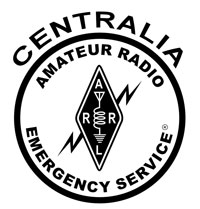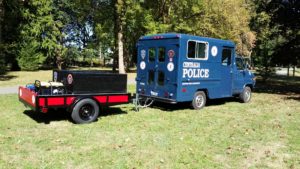 With our Communications Trailer project completed, we spent Monday evening introducing the finished product to the entire team. On Tuesday evening, we set up both the comm van, “Comm II” and the communications trailer in front of Centralia City Hall as part of September’s National Preparedness Month while giving us the opportunity to show off a little to the city officials. We think it was great way to display our newest ARES project.
With our Communications Trailer project completed, we spent Monday evening introducing the finished product to the entire team. On Tuesday evening, we set up both the comm van, “Comm II” and the communications trailer in front of Centralia City Hall as part of September’s National Preparedness Month while giving us the opportunity to show off a little to the city officials. We think it was great way to display our newest ARES project.
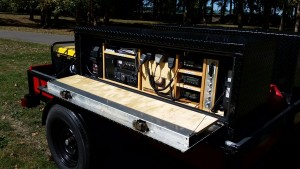
The communications trailer concept germinated when EC Bob Willey read an article in October 2014’s CQ magazine written by William Akins, AK1NS about an emergency communications trailer he created for Nassau County, NY ARES. Centralia ARES is always looking for a useful team project and we started planning. Sometimes, things just take on a life of their own and manage to come together like magic.
After presenting the basic concept to the Centralia ARES team during a meeting in October 2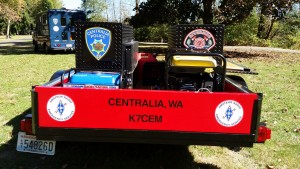 015, one of our team members, Jim Nodell, said he had a similar trailer (5’x8′ single axle utility trailer) which we could have free of charge. The trailer had been out in the weather for some time piled high with yard waste and parts. It also had a bent crank but otherwise was in working order so we grabbed it up.
015, one of our team members, Jim Nodell, said he had a similar trailer (5’x8′ single axle utility trailer) which we could have free of charge. The trailer had been out in the weather for some time piled high with yard waste and parts. It also had a bent crank but otherwise was in working order so we grabbed it up.
Over the next eight months, the team cleaned the trailer, added rust prohibitive paint followed by a coat of black enamel, changed out the decking, installed new taillights, built and painted sides, installed a new crank, had the wheel bearings packed, installed a trailer hitch, safety chains and lighting socket on Comm II and generally made the trailer look presentable.
The Pacific Northwest is not always friendly to an “open trailer” concept as it generally rains here nine out of twelve months of the year. Rain or not, we needed this communications platform.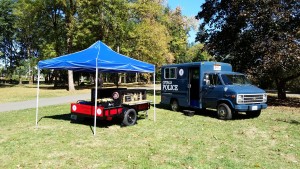 We know from previous experience that when our area floods or when an earthquake occurs, our community can and usually will become four islands, difficult to reach by normal roads. We need ARES communications capability in all four response districts BEFORE bad things happen.
We know from previous experience that when our area floods or when an earthquake occurs, our community can and usually will become four islands, difficult to reach by normal roads. We need ARES communications capability in all four response districts BEFORE bad things happen.
In planning our trailer, we made sure everything was as water tight as possible. We added 18″x 60″ wooden storage boxes along each side to store antenna poles and a 10’x10′ pop up tent. Above the boxes, were installed 18″x 60″ aluminum work boxes. One of these boxes would hold supplies (coax, first aid kit, rope, tools, and even two folding chairs) while the other would become the communications equipment box, holding a large deep cycle battery, an HF radio, a dual band “radio in a box”, a 2 meter radio, another dual band radio and a fire/law radio, and a power supply. Internal lighting included both AC and DC LED lighting along with a conveniently located flashlight as backup.
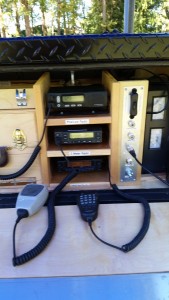
The trailer also holds two generators (one is for the communication van that tows the trailer when it is deployed separately), a solar panel, fuel containers, orange reflective cones and storage for the wheel chocks. After all the painting was completed, we added Centralia Police and Riverside Fire Authority decals as well as ARES decals and our club callsign, K7CEM.
The HF radio in the communications box can easily be removed for use in a shelter or hospital, as are the three (2 meter, dual band, and law/fire radios) in another specially built “radio stack”. The “radio in a box” is also capable of being removed for use elsewhere and there is enough coax on board to reach from inside a shelter outside to the antennas on the trailer.
With the 10’x10′ tent up and sides attached we can be pretty well water tight and temperatures here don’t tend to run into the extremes. While our main communications van would be warmer, dryer and more comfortable, the trailer will serve nicely when needed. We hadn’t planned it, but Facebook follower and Northumberland County, PA AEC recognized the trailer was perfect for wheelchair bound ARES members to operate.
The communications trailer was always, first and foremost, a project designed to bring our team members together and allow them to put hands on a project we could do during the winter. Now completed, we will be testing all systems and including this platform in most if not all of our disaster drills. We completed it just in time. We already have another great project in the works!

